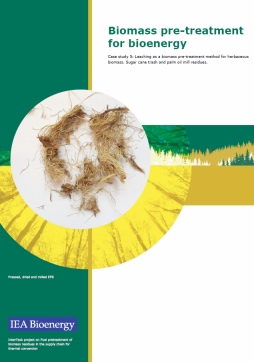Biomass pre-treatment for bioenergy – Case study 5: Leaching as a biomass pre-treatment method for herbaceous biomass
Publications
 Herbaceous biomass originates from plants that typically have a non-woody stem and that dieback at the end of the growing season, in contrast to trees which build up woody biomass over years. Herbaceous biomass comprises a 50% of the EU biomass potential, worldwide this should be a similar percentage. For most applications the high inorganic / ash content causes problems. Particularly Cl and K are problematic. Chlorine (together with K) contributes to corrosion problems in thermal conversion and K and Na are correlated with low ash melting temperatures causing ash slagging and agglomeration. In most cases Cl and K content of herbaceous biomass needs to be reduced by 10 to 20 times to fall within acceptable levels set by current thermal conversion standards. Fortunately K and Cl (and Na) can easily be removed by leaching with water, which has been proven for many types of biomass. Practical methods for doing so have not yet been presented. Tests were executed on oil palm empty fruit bunch (EFB) and sugar cane field trash. Both are typically underutilized residues which currently have little uses.
Herbaceous biomass originates from plants that typically have a non-woody stem and that dieback at the end of the growing season, in contrast to trees which build up woody biomass over years. Herbaceous biomass comprises a 50% of the EU biomass potential, worldwide this should be a similar percentage. For most applications the high inorganic / ash content causes problems. Particularly Cl and K are problematic. Chlorine (together with K) contributes to corrosion problems in thermal conversion and K and Na are correlated with low ash melting temperatures causing ash slagging and agglomeration. In most cases Cl and K content of herbaceous biomass needs to be reduced by 10 to 20 times to fall within acceptable levels set by current thermal conversion standards. Fortunately K and Cl (and Na) can easily be removed by leaching with water, which has been proven for many types of biomass. Practical methods for doing so have not yet been presented. Tests were executed on oil palm empty fruit bunch (EFB) and sugar cane field trash. Both are typically underutilized residues which currently have little uses.
Extraction experiments with EFB and sugar and cane trash have shown that potassium and chloride concentrations can be reduced by 80% respectively 90% after four consecutive extractions with fresh water, bringing Cl and K down or close to acceptable levels. Experiments showed that one kilo of dry matter biomass absorbed approximately 2 litres of water. After 30 minutes (EFB) and 15 minutes (trash) equilibrium was reached and the water was removed. The loss of biomass after 4 washing cycles was 6% DM for EFB and 15% for trash.
Under practical conditions repeated leaching with water will require too much water and generate large quantities of polluted water which is hard to recycle.
Using a counter-current extraction system would make it possible to use 3.3 litre water per kg of (DM) biomass to remove 94% of K and Cl in 10 extraction stages. Or 5.4 litre of water in 4 counter-current stages.
The cost of extraction on a scale of 40.000 tons DM (equivalent to a large oil palm mill) was estimated to be approximately 8 US$/ton (6.5 €/ton). Which is 5 to 10% of the delivery cost of biomass pellets to European harbours.
Authors: Koen Meesters, Wolter Elbersen, Pascal van der Hoogt, Hristo Hristov
Download here: CS5 Leaching as a biomass pre-treatment method for herbaceous biomass
